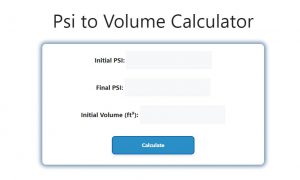About Psi to Volume Calculator (Formula)
The Psi to Volume Calculator is an essential tool for anyone working with gases, liquids, or other compressible substances. This calculator allows users to determine how the volume of a substance changes when subjected to varying pressure conditions. Understanding these changes is crucial in many fields, including engineering, chemistry, and physics, where pressure-volume relationships are fundamental. This article will explain how to use the calculator, provide a clear example, and answer frequently asked questions related to psi and volume calculations.
Formula
The formula for calculating volume from psi is:
Volume from PSI = (Initial PSI * Initial Volume) / Final PSI.
How to Use
- Gather Your Data: Obtain the initial pressure (in psi), the initial volume (in the desired volume unit), and the final pressure (in psi) of the gas or liquid.
- Input the Values: Enter the initial PSI, initial volume, and final PSI into the calculator.
- Perform the Calculation: Use the formula to compute the volume under the final pressure conditions.
- Review the Results: Analyze the calculated volume to understand how the substance will behave under the new pressure.
Example
Consider a scenario where the initial pressure of a gas is 30 PSI, the initial volume is 10 liters, and the final pressure is 15 PSI. To find the new volume using the formula:
Volume from PSI = (Initial PSI * Initial Volume) / Final PSI
Volume from PSI = (30 PSI * 10 liters) / 15 PSI
Volume from PSI = 300 / 15
Volume from PSI = 20 liters.
In this example, the new volume at 15 PSI is 20 liters.

FAQs
- What is PSI?
PSI stands for pounds per square inch, a unit of pressure used to measure the force exerted over a specific area. - Why is the PSI to Volume Calculator important?
This calculator is important for understanding how pressure affects the volume of gases and liquids, which is crucial in many scientific and industrial applications. - Can I use this calculator for both gases and liquids?
Yes, the calculator can be used for both gases and liquids, though the compressibility of gases will often lead to more significant volume changes. - What if my initial PSI is lower than the final PSI?
If the initial PSI is lower than the final PSI, the formula will still provide a volume; however, the interpretation will depend on the context of the situation. - Is the volume calculated always accurate?
The accuracy of the volume calculation depends on the precision of the input data and the assumptions of the gas or liquid behavior. - How do temperature changes affect volume calculations?
Temperature changes can affect volume, particularly in gases, as they may expand or contract with temperature variations according to Charles’s law. - What are the common applications of the PSI to Volume Calculator?
Applications include designing pressure vessels, calculating gas storage volumes, and assessing pneumatic systems in engineering. - Can the calculator be used for variable pressures?
The calculator assumes constant initial and final pressures; for variable pressures, more complex equations may be required. - How do I convert PSI to other pressure units?
PSI can be converted to other units like bar or pascals using conversion factors (1 PSI = 0.06895 bar; 1 PSI = 6894.76 pascals). - What is the relationship between pressure and volume?
According to Boyle’s law, the volume of a gas is inversely proportional to its pressure at constant temperature. - What if I have a mixture of gases?
For mixtures, consider the partial pressures and volumes of each gas component when using the calculator. - Can this calculator help in industrial processes?
Yes, it can aid in processes like gas compression, storage, and transport in various industries. - How do I know if my volume calculation is reasonable?
Compare your results with expected values based on empirical data or conduct experimental measurements. - Does the calculator account for compressibility?
The basic formula assumes ideal gas behavior; for real gases, compressibility factors may need to be applied. - What happens if I enter incorrect values?
Incorrect values will lead to erroneous volume calculations, so it’s crucial to double-check your inputs. - Can I use the calculator for high-pressure scenarios?
Yes, but keep in mind that at very high pressures, gases may behave non-ideally, and corrections may be necessary. - How can I validate my results?
Validate results by comparing them with theoretical predictions or conducting controlled experiments. - What if I need to calculate changes at multiple pressures?
Repeat the calculation for each pressure scenario separately to analyze changes systematically. - Is there a limit to the volume I can input?
The volume input may depend on the calculator’s design; generally, it should accommodate typical values for your application. - What should I do if I encounter discrepancies?
If discrepancies arise, recheck your calculations and assumptions, or consult with a professional in the field.
Conclusion
The Psi to Volume Calculator is an invaluable tool for understanding how pressure influences volume in gases and liquids. By using this calculator, users can make informed decisions in various applications, from engineering to scientific research. Whether you’re a student, professional, or hobbyist, this tool simplifies complex calculations and enhances your ability to predict behavior under different pressure conditions. Regular use can lead to greater accuracy and efficiency in your projects and studies.